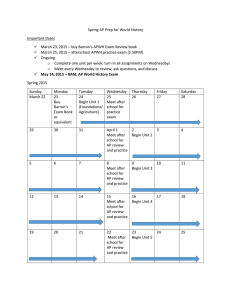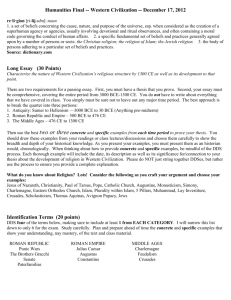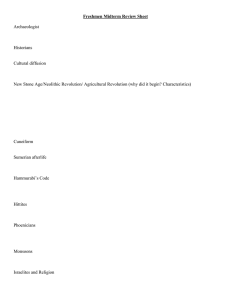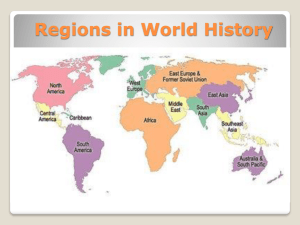Key Terms – no written documents; History: written proof of history Prehistory
advertisement
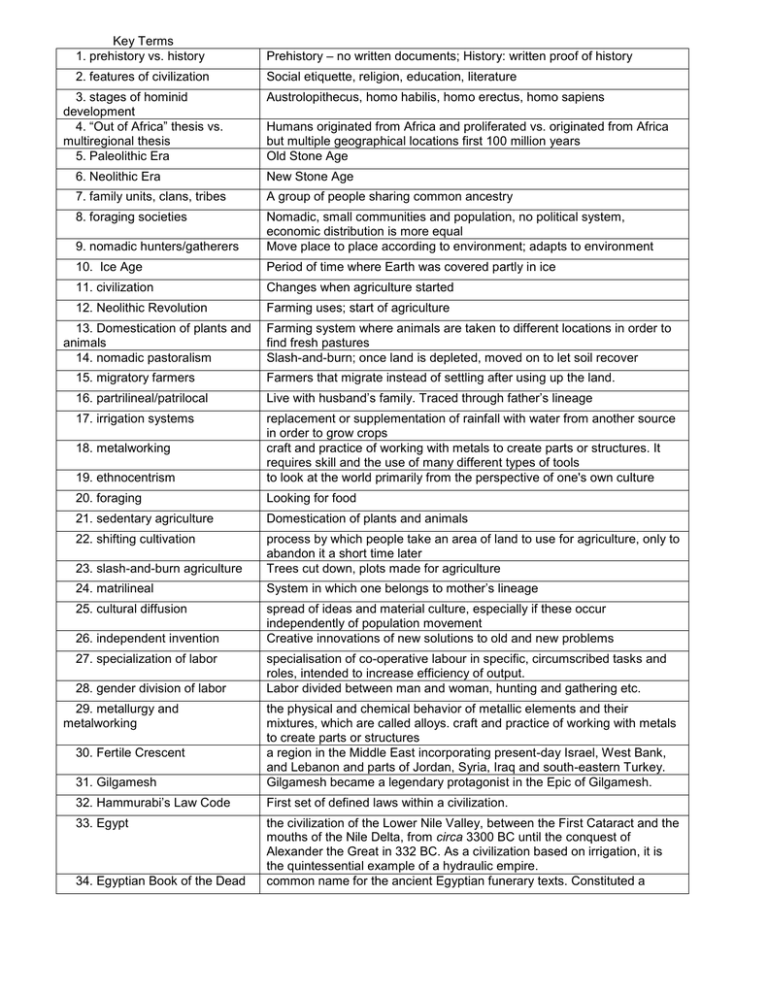
Key Terms 1. prehistory vs. history Prehistory – no written documents; History: written proof of history 2. features of civilization Social etiquette, religion, education, literature 3. stages of hominid development 4. “Out of Africa” thesis vs. multiregional thesis 5. Paleolithic Era Austrolopithecus, homo habilis, homo erectus, homo sapiens Humans originated from Africa and proliferated vs. originated from Africa but multiple geographical locations first 100 million years Old Stone Age 6. Neolithic Era New Stone Age 7. family units, clans, tribes A group of people sharing common ancestry 8. foraging societies 9. nomadic hunters/gatherers Nomadic, small communities and population, no political system, economic distribution is more equal Move place to place according to environment; adapts to environment 10. Ice Age Period of time where Earth was covered partly in ice 11. civilization Changes when agriculture started 12. Neolithic Revolution Farming uses; start of agriculture 13. Domestication of plants and animals 14. nomadic pastoralism Farming system where animals are taken to different locations in order to find fresh pastures Slash-and-burn; once land is depleted, moved on to let soil recover 15. migratory farmers Farmers that migrate instead of settling after using up the land. 16. partrilineal/patrilocal Live with husband’s family. Traced through father’s lineage 17. irrigation systems 19. ethnocentrism replacement or supplementation of rainfall with water from another source in order to grow crops craft and practice of working with metals to create parts or structures. It requires skill and the use of many different types of tools to look at the world primarily from the perspective of one's own culture 20. foraging Looking for food 21. sedentary agriculture Domestication of plants and animals 22. shifting cultivation 23. slash-and-burn agriculture process by which people take an area of land to use for agriculture, only to abandon it a short time later Trees cut down, plots made for agriculture 24. matrilineal System in which one belongs to mother’s lineage 25. cultural diffusion spread of ideas and material culture, especially if these occur independently of population movement Creative innovations of new solutions to old and new problems 18. metalworking 26. independent invention 27. specialization of labor 28. gender division of labor 29. metallurgy and metalworking specialisation of co-operative labour in specific, circumscribed tasks and roles, intended to increase efficiency of output. Labor divided between man and woman, hunting and gathering etc. 31. Gilgamesh the physical and chemical behavior of metallic elements and their mixtures, which are called alloys. craft and practice of working with metals to create parts or structures a region in the Middle East incorporating present-day Israel, West Bank, and Lebanon and parts of Jordan, Syria, Iraq and south-eastern Turkey. Gilgamesh became a legendary protagonist in the Epic of Gilgamesh. 32. Hammurabi’s Law Code First set of defined laws within a civilization. 33. Egypt the civilization of the Lower Nile Valley, between the First Cataract and the mouths of the Nile Delta, from circa 3300 BC until the conquest of Alexander the Great in 332 BC. As a civilization based on irrigation, it is the quintessential example of a hydraulic empire. common name for the ancient Egyptian funerary texts. Constituted a 30. Fertile Crescent 34. Egyptian Book of the Dead 35. pyramids 36. hieroglyphics 37. Indus valley civilization 38. early China 39. the Celts 40. the Hittites and iron weapons 41. the Assyrians and cavalry warfare 42. The Persian Empire 43. The Hebrews and monotheism 44. the Phoenicians and the alphabet 45. the Lydians and coinage 46. Greek city-states 47. democracy 48. Persian Wars 49. Peloponnesian War 50. Alexander the Great 51. Hellenism 52. Homer 53. Socrates and Plato 54. Aristotle collection of spells, charms, passwords, numbers and magical formulas for use by the deceased in the afterlife, describing many of the basic tenets of Egyptian mythology. They were intended to guide the dead through the various trials that they would encounter before reaching the underworld. Knowledge of the appropriate spells was considered essential to achieving happiness after death. tombs for egyptian kings. system of writing used by the Ancient Egyptians, using a combination of logographic, syllabic, and alphabetic elements. an ancient civilization thriving along the Indus River and the GhaggarHakra river in what is now Pakistan and western India. The Indus Valley Civilization is also sometimes referred to as the Harappan Civilization of the Indus Valley, in reference to its first excavated city of Harappa Xia, Shang, Zhou, Warring States Period, Qin, Han group of peoples that occupied lands stretching from the British Isles to Gallatia. Went to war with Romans. First to work iron, first to enter Iron Age. controlled central Anatolia, northwestern Syria down to Ugarit, and Mesopotamia down to Babylon, lasted from roughly 1680 BC to about 1180 BC. After 1180 BC, the Hittite polity disintegrated into several independent city-states, some of which survived as late as around 700 BC. indigenous people of Mesopotamia and have a history spanning over 6700 years. Started cavalry warfare? used to refer to a number of historic dynasties that have ruled the country of Persia (Iran). the Achaemenid Empire that emerged under Cyrus the Great that is usually the earliest to be called "Persian." Successive states in Iran before 1935 are collectively called the Persian Empire by Western historians descendants of biblical Patriarch Eber; were people who lived in the Levant, which was politically Canaan when they first arrived in the area. First monotheistic group; Yahweh. enterprising maritime trading culture that spread right across the Mediterranean during the first millennium BC. First form of language. ancient kingdom of Asia Minor, first to mint coins. region controlled exclusively by Greek, and usually having sovereignty. Ex. Crete form of government in which policy is decided by the preference of the majority in a decision-making process, usually elections or referendums, open to all or most citizens. a series of conflicts between the Greek world and the Persian Empire that started about 500 BC and lasted until 448 BC. began in 431 BC between the Athenian Empire (or The Delian League) and the Peloponnesian League which included Sparta and Corinth. United Ancient Greece; Hellenistic Age, conquered a large empire. shift from a culture dominated by ethnic Greeks to a culture dominated by Greek-speakers of various ethnicities, and from the political dominance of the city-state to that of larger monarchies. In this period the traditional Greek culture was changed by strong Eastern influences, especially Persian, in aspects of religion and government. Cultural centers shifted away from mainland Greece, to Pergamon, Rhodes, Antioch and Alexandria. legendary early Greek poet and rhapsode traditionally credited with authorship of the major Greek epics Iliad and Odyssey Greek philosopher/student. Along with Plato, he is often considered to be one of the two most influential philosophers in Western thought. He wrote many books about physics, poetry, zoology, logic, government, and biology. 55. Western scientific thought 56. Roman Republic 57. plebians vs. patricians 58. Punic Wars 59. Julius Caesar 60. Roman Empire 61. Qin, Han, Tang Dynasties 62. Shi Huangdi 63. Chinese tributary system 64. the Silk Road 65. Nara and Heian Japan 66. the Fujiwara clan 67. Lady Murasaki and “The Tale of Genji 68. Central Asia and Mongolia 69. the Aryan invasion of India 70. Dravidians 71. Indian caste system 72. Ashoka 73. Constantinople/Byzantine Empire 74. Justinian 75. early Medieval Europe “Dark Ages” Systematic apporach of observation, hypothesis formation, hypothesis testing and hypothesis evaluation that forms the basis for modern science. republican government of the city of Rome and its territories from 510 BC until the establishment of the Roman Empire, which sometimes placed at 44 BC the year of Caesar's appointment as perpetual dictator or, more commonly, 27 BC the year that the Roman Senate granted Octavian the title "Augustus". peasants/slaves vs. elite/upperclass series of three wars fought between Rome and the Phoenician city of Carthage. Reason: clash of interests between the expanding Carthaginian and Roman spheres of influence. Roman military and political leader. He was instrumental in the transformation of the Roman Republic into the Roman Empire. Dictator for life. Ancient Roman polity in the centuries following its reorganization under the leadership of Octavian. First three dynasties of China that we have recordings of. First of 'centralized' China. king of the Chinese State of Qin from 247 BC to 221 BC, and then the first emperor of a unified China from 221 BC to 210 BC, ruling under the name First Emperor. form of conducting diplomatic and political relations with China before the fall of the Qin Dynasty. interconnected series of routes through Southern Asia traversed by caravan and ocean vessel. ast division of classical Japanese history, running from 794 to 1185. The Heian period is considered the peak of the Japanese imperial court and noted for its art, especially poetry and literature. Nara: agricultural in nature, centered around villages. Most of the villagers followed the Shinto religion, based around the worship of natural and ancestral spirits. dominated the Japanese politics of Heian period. Written by Murasaki. First novel of japanese/world literature. historically been closely tied to its nomadic peoples and the Silk Road. As a result, it has acted as a crossroads for the movement of people, goods, and ideas between Europe, the Middle East, South Asia, and East Asia Aryans invaded and destroyed Indus River civilization, settled, moved to Ganges River. people of southern and central India and northern Sri Lanka who speak Dravidian languages, the best known of which are Tamil, Telugu, Kannada and Malayalam. system was a basically simple division of society into four castes (Brahman, Kshatriya, Vaishya and Sudra) arranged in a hierarchy, with the "Untouchable" (Dalit) outcasts below this structure. But socially the caste system was more complicated, with many more castes and sub-castes and other divisions. of the Mauryan empire from 273 BC to 232 BC. A convert to Buddhism. Made into second capital by Constantine in attempts to help Rome turn its economy around. r. 527 - 565 CE – Justinian is the Eastern Roman emperor who tried to restore the unity of the old Roman Empire. He issued the most famous compilation of Roman Law. He was unable to maintain a hold in Italy and lost the provinces of north Africa. It was the last effort to restore the Mediterranean unity. a period in history between the last emperor of Rome, 475 A.D., and the Renaissance, about 1450 (15th century). Art production during this period was dominated by the Catholic Church. 76. feudalism 77. Charlemagne 78. Mohammed and the foundation of Islam 79. Umayyad and Abbasid caliphates 80. Bantu and their migrations 81. Nubia 82. Ghana 83. Olmec 84. Maya 85. Andean societies 86. Mississippian culture The social organization created by exchanging grants of lands r fiefs in return for formal oaths of allegiance and promises of loyal service; typical of Zhou dynasty and European Middle Ages; greater lords provided protection and aid to lesser lords in return for military service. Charles the Great; Carolingian monarch who established substantial empire in France and Germany (800 C.E). He helped restore some church-based education in western Europe, and the level of intellectual activity began a slow recovering. After death, the empire could not survive. In 610/earlier, he received the first of many revelations: Allah transmitted to him through the angel Gabriel. Believed in the five pillars: (1) “There is no God but Allah, and Muhammad is his Prophet.” (2) Pray facing the Mecca five times a day. (3) Fast during the month of Ramadan which enhances community solidarity and allowed the faithful to demonstrate their fervor. (4) The zakat, tithe for charity, strengthened community cohesion. (5) The haji, pilgrimage to the holy city Mecca, to worship Allah at the Ka’ba. Umayyad: Clan of Quraysh that dominated politics and commercial economy of Mecca; clan later able to establish dynasty as rulers of Islam. Abbasid: Dynasty that succeeded the Umayyads as caliphs within Islam (750 C.E.) A caliph is a political and religious successor to Muhammad. To the 10th century, the wave reached the east African interior. Bantuspeaking herders in the north and farmers in the south mixed with older populations in the region. Others were moving to the African coast. Thus creating coastal trading ports. The Coptic (Christians of Egypt) influence spread up the Nile into Nubia (the ancient land of Kush). Muslims attempted to penetrate Nubia and met stiff resistance in the 9th century (left Christian descendants of ancient Kush – left as independent Christian kingdom until 13th century). Formed by 8th century by exchanging gold from the forests of west Africa for salt/dates from the Sahara or for goods from Mediterranean north Africa. Camels, were introduced tcreating better trade. By 3rd century C.E. it rose to power by taxing the salt and gold exchanged within its borders. 10th century, rulers had converted to Islam and were at its height of power. Almoravid armies invaded Ghana from north Africa (1076), the power was declining despite the kingdom’s survival. 13th century, new states rose. Cultural tradition that arose at San Lorenzo and La Venta in Mexico (1200 BCE); featured irrigated agriculture, urbanism, elaborate religion, beginnings of calendrical and writing systems. Classic culture emerging in southern Mexico and Central American contemporary with Teotihuacán; extended over broad religion; featured monumental architecture, written language, calendrical and mathematical systems, highly developed religion. developed in the second millennium BCE in the central Andes and the central Pacific coast of South America. While oldest artifacts carbon date around 9750 BCE, evidence of a significant economic surplus begins around 2000 BCE. The Andean civilizations included the urbanized cultures of Chav�n, Moche, Ica-Nazca, Chimu, Tiwanaku, Aymara, Chachapoya, and other Pre-Inca cultures. The semi-urbanized Inca conquered greater Peru in the 15th century. Then, in the 16th century, the European fiefdom of Spain conquered Peru. The Mississippian culture was a Mound-building Native American culture that flourished in the Midwestern, Eastern, and Southeastern United States in the centuries leading up to European contact. The Mississippian way of life began to develop around 900 A.D. in the Mississippi River Valley (for which it is named). Cultures in the Tennessee River Valley may have also begun to develop Mississippian characteristics at this point. The Mississippian (archaeological) Stage is usually considered to come to a close with the arrival of European contact, although the Mississippian way of life continued among their descendants. There are many regional 87. Anasazi 88. cultural diffusion versus independent innovation 89. aristocracy variants of the Mississippian way of life, which are treated together in this article. Ancestral Puebloans were a prehistoric Native American civilization centered around the present-day Four Corners area of the Southwest United States. spread through cultures vs. independent inventing system of government with "rule by the best" 90. parliamentary bodies Senate and ……[peasant voting body] 91. oligarchy Political regime where most political power effectively rests with a small segment of society (typically the most powerful, whether by wealth, military strength, ruthlessness, or political influence). Republic - state or country that is led by people who do not base their political power on any principle beyond the control of the people living in that state or country. Democracy - form of government in which policy is decided by the preference of the majority in a decision-making process, usually elections or referendums, open to all or most citizens. 92. republics/democracies 93. theocracy 94. slavery vs. serfdom 95. war 96. trade routes 97. Polynesian migrations 98. Eurasia’s great age of migrations form of government in which a religion or faith plays a dominant role. were not property themselves and could not be sold apart from the land which they worked. Serfdom is the forced labour of serfs, on the fields of the privileged land owners, in return for protection and the right to work on their leased fields. state of widespread conflict between states, organisations, or relatively large groups of people, which is characterised by the use of violent, physical force between combatants or upon civilians. sequence of pathways and stopping places used for the commercial transport of cargo. most likely began from the islands of Fiji, Tonga and Samoa, spreading east, south, and north, covering millions of square miles of ocean sparsely dotted with islands.Polynesians migrated throughout the Pacific in sailing canoes, ultimately forming a triangle, whose points are Aotearoa (New Zealand) to the southwest, Rapa Nui (Easter Island) to the east, and the Hawaiian Archipelago to the north. Increase in migrations from Eurasia. 99. polytheism 100. Zoroastrianism belief in, or worship of, multiple gods or divinities. one of the world's oldest monotheistic religions. Worship of Wisdom 101. the Ten Commandments list of religious and moral imperatives which, according to the Bible, was spoken by the god YHWH to Moses on Mount Sinai and engraved on two stone tablets. refers to the first section of the Tanakh–the first five books of the Hebrew Bible, or the Five Books of Moses, but can also be used in the general sense to also include both the Written and Oral Law. of a series of disputations that took place in Europe during the Middle Ages, a group of rabbis were called upon to defend the Talmud. The attacks against Judaism was based on a long held idea that rabbis had "distorted" the Bible through their interpretations, keeping Jews from "adopting" Christianity. "Yahweh", God's name. 102. the Torah 103. the Talmud 104. YHWH 105. Abraham 106. Moses and the Exodus from Egypt – Passover the first of the Old Testament patriarchs and the father of Isaac; according to Genesis, God promised to give Abraham's family (the Hebrews) the land of Canaan (the Promised Land); God tested Abraham by asking him to sacrifice his son; "Judaism, Christianity, and Islam each has a special claim on Abraham" Passover to celebrate the day the Jews were led out of Egypt and into their land by Moses. 107. David and Solomon David - Greatest king of jews. Solomon - wisest king on earth; fell to evilness, turned away from his God. 108. Jewish Diaspora to the dispersion of the Jewish people throughout the world. The notion of diaspora is commonly accepted to have begun with the Babylonian Captivity in 597 BCE. 109. Vedism (Rig-Veda) of hymns counted among the four Hindu religious scriptures known as the Vedas, and contains the oldest texts preserved in any Indo-Iranian language. encompasses many religious traditions that widely vary by culture, as well as many diverse beliefs and sects. The estimates of Hinduism's origin vary from 3102 BCE to 1300 BCE, and it is generally regarded as the world's oldest major religion. Samsara - transmigration of soul from one body to another, Karma - the law behind reincarnation, Dharma - cosmic ethnics 110. Hinduism (Upanishads, Mahabharata, Bhagavad-Gita) 111. samsara, karma, dharma 112. Brahma, Vishnu, Shiva The Creator, The Preserver, The Destroyer. 113. Laws of Manu work of Hindu law and ancient Indian society, written c.200 in India. It is one of the eighteen Smritis of the Dharma Sastra (or "laws of righteous conduct"); religion and philosophy based on the teachings of the Buddha, Siddhārtha Gautama. Originating in India, Buddhism gradually spread throughout Asia to Central Asia, Sri Lanka, Tibet, Southeast Asia, as well as the East Asian countries of China, Mongolia, Korea, Japan, Vietnam and Thailand. 114. Buddhism 115. Four Noble Truths fundamental insight or enlightenment of Sakyamuni Buddha (the historical Buddha), which led to the formulation of the Buddhist philosophy. 116. Eightfold Path way to the cessation of suffering, the fourth part of the Four Noble Truths. 117. Siddhartha Gautama Buddha; founder of Buddhism. 118. nirvana not a place nor a state, it is an absolute truth to be realized, and a person can do so without dying. 119. Theravada (Hinayana) and Mahayana Buddhism 120. Daoism 121. Tao-te Chng and the I Ching T - Buddha is Teacher; M - Buddha is God. set of philosophical teachings and religious practices rooted in a specific metaphysical understanding of the Chinese character Tao. For taoists, Tao could be described as the continuity principle behind the whole process of the constantly changing Universe. The Book of the Way and its Virtue (see chapter below on translating the title) is an ancient Chinese scripture. The work is traditionally said to have been written around 600 BCE by the famous sage called Laozi. oldest of the Chinese classic texts. It describes an ancient system of cosmology and philosophy which is at the heart of Chinese cultural beliefs. 122. Laozi Founder/teacher of taoism. 123. Confucianism an East Asian ethical and philosophical system originally developed from the teachings of Confucius. 124. Analects record of speeches by Confucius and his disciples, as well as the discussions they held. 125. K’ung Fu-tzu (Confucius) Teacher/founder of Confucianism. 126. Mandate of Heaven blessing of Heaven and that if a king ruled unwisely, Heaven would be displeased and would give the Mandate to someone else. 127. Judeo-Christian tradition body of concepts and values which are thought to be held in common by Christianity and Judaism, and typically considered a fundamental basis for Western legal codes and moral values. Son of God. 128. Jesus of Nazareth 129. the Bible (Old and New Testament) Holy text of Christianity. 130. Crucifixion and Resurrection (Easter) Died on Good Friday, resurrected on Easter Sunday. 131. Peter and Paul 132. Constantine and the Edict of Milan 133. Saint Augustine 134. Eastern Orthodoxy and Roman Catholicism (Great Schism of 1054) Main disciples of Jesus; carried on teaching after death. Outlawed/killed people practising christianity. saint and the pre-eminent Doctor of the Church according to Roman Catholicism, and is considered by Evangelical Protestants to be (together with the Apostle Paul) the theological fountainhead of the Reformation teaching on salvation and grace reflecting its claim to be the preserver of the original Christian traditions as well as those established by the church during the first 1000 years of its existence; maintain a belief that their episcopate can be traced directly back to the Apostles 135. Islam (the Qur’ran) "the submission to God" is a monotheistic faith, one of the Abrahamic religions, and the world's second largest religion. 136. Allah God's name in Islam. 137. Mohammed Last prophet of God. 138. Mecca The city is revered as the holiest site of Islam, and a pilgrimage to it is required of all Muslims who can afford to go 139. the Kaaba building located inside the mosque known as Masjid al Haram in Mecca (Makkah). The mosque has been built around the Kaaba. The Kaaba is the holiest place in Islam. Medina is the second holiest city of Islam, after Mecca. Its importance as a religious site derives from the presence there of the Shrine of the Prophet Mohammad by Masjid al-Nabawi or the Mosque of the Prophet Sunnis believe this process was conducted in a fair and proper manner and accept Abu Bakr as a righteous and rightful Caliph. The second major sect, the Shia, believe that the Prophet had appointed his son-in-law Ali ibn Abi Talib as his successor years earlier during an announcement at Ghadir Khom. 140. Medina (the Hegira) 141. Sunni versus Shiite 142. Sufism school of esoteric philosophy in Islam, which is based on the pursuit of spiritual truth as a definite goal to attain. In modern language it might also be referred to as Islamic spirituality or Islamic mysticism.
